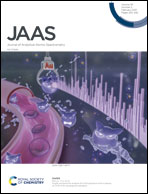Quantitative elemental analysis of aluminum alloys with one-point calibration high repetition rate laser-ablation spark-induced breakdown spectroscopy
Abstract
One-point calibration (OPC) high repetition rate laser-ablation spark-induced breakdown spectroscopy (HRR LA-SIBS) was used to realize the quantitative elemental analysis of aluminum alloy samples. In the experiments, a compact acousto-optically Q-switched Nd:YAG laser operated at a 1 kHz pulse repetition rate was used as the ablation laser and spark discharge was used to enhance the plasma emission. One standard aluminum alloy sample with a certified elemental concentration was used for calibration in the OPC procedure. Then compositions of four other aluminum alloy samples were predicted using the OPC HRR LA-SIBS technique and the results were compared with the certified concentration for each element. The predicted concentrations were found to be in good agreement with the certified concentrations and the averaged relative errors are 0.065%, 13.03%, 11.97%, 19.45%, 9.77% and 7.81% for Al, Mg, Cu, Cr, Mn and Zn, respectively. It is demonstrated that OPC HRR LA-SIBS is able to enable convenient and reliable quantitative analysis for both major and minor elements in aluminum alloys.



 Please wait while we load your content...
Please wait while we load your content...